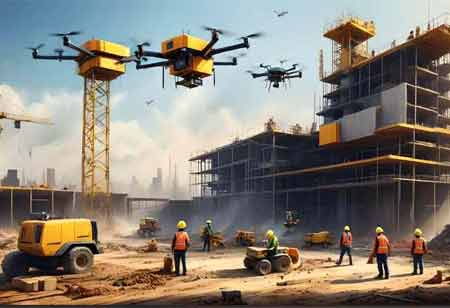THANK YOU FOR SUBSCRIBING
Be first to read the latest tech news, Industry Leader's Insights, and CIO interviews of medium and large enterprises exclusively from Construction Tech Review
The Science Behind Smart Concrete Monitoring
Advanced temperature-sensing technologies are remodeling concrete curing by providing real-time data, optimizing timelines, enhancing durability, and transitioning to data-driven methods for improved construction efficiency.

By
Construction Tech Review | Tuesday, November 04, 2025
Stay ahead of the industry with exclusive feature stories on the top companies, expert insights and the latest news delivered straight to your inbox. Subscribe today.
An innovative approach to concrete curing drives the construction industry: the strategic integration of advanced temperature-sensing technologies. This paradigm shift is fundamentally reshaping project timelines, transitioning from conventional, time-based curing protocols to a data-driven methodology. By providing real-time insights into the concrete's internal state, temperature sensing enables unprecedented precision in managing the hydration process, thereby accelerating construction schedules and enhancing material performance.
The process of concrete curing is fundamentally a complex chemical reaction. Upon mixing cement with water, a process known as hydration commences, culminating in the formation of a hardened matrix of calcium silicate hydrate (C-S-H). This exothermic reaction generates heat, and its rate is contingent upon temperature. Elevated temperatures can induce accelerated early strength acquisition; however, this may compromise long-term durability and heighten the propensity for thermal cracking. Conversely, unduly low temperatures can substantially impede hydration, thereby delaying strength development and potentially leading to freezing damage before adequate strength is achieved.
Traditional curing methods relied on empirical rules and predetermined durations, frequently resulting in either overly cautious delays or premature interventions. The intrinsic variability in environmental conditions, mix designs, and structural dimensions rendered these fixed timelines suboptimal. The absence of precise, in-situ data often led to decisions regarding formwork removal, post-tensioning, or the application of subsequent loads being made with a substantial margin of error, thereby affecting project efficiency and overall structural integrity.
The Rise of Real-Time Temperature Sensing
The development of advanced temperature sensing technologies has significantly transformed this field. The era of relying solely on ambient air temperature or infrequent manual measurements has come to an end. Contemporary solutions involve the direct embedding of sensors within the concrete mass at pivotal locations. These sensors, encompassing traditional thermocouples as well as more sophisticated wireless and fiber-optic systems, continuously monitor and transmit temperature data, thereby providing a detailed, real-time understanding of the concrete's internal thermal profile.
This real-time data stream serves as the foundational element for optimized curing processes, enabling the precise monitoring of the heat of hydration as it develops within the concrete. By comprehending the actual temperature history, construction professionals can effectively apply the maturity method, a validated principle that correlates temperature history with the progression of concrete strength. This approach facilitates decision-making based on the concrete's actual strength gain, rather than a predetermined timeframe, thereby supported by continuous temperature surveillance.
Optimizing Timelines Through Data-Driven Decisions
Real-time temperature sensing in concrete operations enables project managers and engineers to optimize construction timelines with exceptional precision by providing accurate data on temperature and corresponding strength gain, allowing them to determine the exact moment the material reaches sufficient strength for critical operations. This capability eliminates arbitrary waiting periods for formwork removal, accelerates cycle times for repetitive pours, ensures optimal timing for post-tensioning to prevent overstressing, and allows earlier loading or traffic opening for infrastructure based on verified strength rather than conservative estimates. In cold climates, it supports effective heating and insulation strategies to maintain hydration rates, prevent freezing damage, and avoid unnecessary costs or extended curing periods, while in mass concrete pours, it enables proactive thermal management—such as chilled water circulation through embedded pipes—to maintain uniform temperatures, reduce detrimental differentials, and prevent cracking. By replacing guesswork with verifiable data, real-time temperature sensing enables faster and more confident decision-making, resulting in shorter construction durations, enhanced efficiency, and improved project fluidity.
Enhancing Quality and Durability
Beyond accelerating project timelines, precise temperature sensing is integral to enhancing the long-term quality and durability of concrete structures. Maintaining optimal temperature conditions during the curing period is essential for ensuring complete and efficient cement hydration. When temperatures are meticulously controlled, the concrete achieves its full designed compressive strength, minimizes the risk of thermal cracking—particularly in large pours—thus preserving structural integrity, and develops a denser, less permeable matrix that improves resistance to environmental degradation, including freeze-thaw cycles, chemical attack, and the ingress of harmful substances. Moreover, real-time temperature monitoring enables timely adjustments to curing protocols, ensuring consistent performance across various sections of the structure and under differing environmental conditions. Collectively, these measures foster the development of more resilient, durable, and long-lasting concrete infrastructure.
Advancements in sensor technology and data collection methods drive the field of temperature sensing in concrete. Traditional solutions, such as thermocouples, remain widely used due to their cost-effectiveness and reliability. These devices convert temperature into electrical signals, which are recorded by data loggers, but require wired connections to external equipment for data retrieval. Wired temperature and maturity loggers offer a more integrated approach, combining thermistors and onboard batteries to store temperature data internally, which can be periodically downloaded through wired connections. In contrast, wireless embedded sensors represent a significant innovation, enabling real-time, remote monitoring by transmitting data directly via Bluetooth or cellular networks to mobile applications or cloud platforms, thereby eliminating the need for physical site visits. Fiber optic sensors are emerging as a promising solution, capable of providing distributed temperature measurements along their length to deliver detailed thermal profiles of large concrete structures. Their robustness and immunity to electromagnetic interference further enhance their applicability in complex environments.
The future of concrete curing is delineated by intelligent, autonomous, and highly efficient processes. The continuous progression of temperature sensing, alongside advancements in data analytics and automation, portends a redefinition of industry benchmarks. One can foresee more integrated systems in which temperature data is not merely passively observed but actively utilized to initiate automated modifications to curing environments, such as intelligent misters or heating elements, thereby guaranteeing optimal conditions with minimal human involvement.
This ongoing progression toward more intelligent curing techniques will yield further efficiencies, extend structural longevity, and foster more sustainable construction methodologies. The precise discipline of concrete curing, once reliant on empirical knowledge and informed conjecture, is now being redefined as a scientific pursuit, driven by the invaluable insights gained from real-time temperature data. This transformative shift not only facilitates expedited construction but also aims to establish superior, more enduring, and more dependable infrastructure for the future.
I agree We use cookies on this website to enhance your user experience. By clicking any link on this page you are giving your consent for us to set cookies. More info

 Copyright © 2025 All Rights Reserved | by:
Copyright © 2025 All Rights Reserved | by: Construction Tech Review
| Subscribe | About us | Sitemap| Editorial Policy| Feedback Policy






